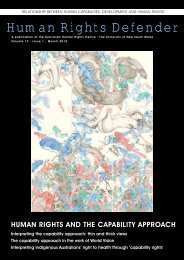'Photojournalism as a line of defence in war' by Brigit Morris
'Photojournalism as a line of defence in war' by Brigit Morris
'Photojournalism as a line of defence in war' by Brigit Morris
Create successful ePaper yourself
Turn your PDF publications into a flip-book with our unique Google optimized e-Paper software.
editorialClaudia TazreiterJust before Christm<strong>as</strong> reports <strong>of</strong> protests<strong>in</strong> Tunisia hit the <strong>in</strong>ternational media. Welearned that citizens were gather<strong>in</strong>g <strong>in</strong> thestreets <strong>of</strong> towns and cities to protest aga<strong>in</strong>steconomic conditions, the lack <strong>of</strong> politicalfreedoms and to push for regime change. Weheard <strong>of</strong> the plight <strong>of</strong> a Tunisian fruit seller,Mohamed Bouazizi, a young man who cameto have a pivotal role <strong>in</strong> spark<strong>in</strong>g protest notjust <strong>in</strong> Tunisia, but across North Africa andthe Middle E<strong>as</strong>t. Mohamed had become thema<strong>in</strong> breadw<strong>in</strong>ner for his family at the age <strong>of</strong>10, sell<strong>in</strong>g fresh produce <strong>as</strong> a street vendor <strong>in</strong>the prov<strong>in</strong>cial town <strong>of</strong> Sidi Bouzid. At the age<strong>of</strong> 26 he cont<strong>in</strong>ued this work <strong>in</strong> the face <strong>of</strong>daily bully<strong>in</strong>g <strong>by</strong> local police <strong>of</strong>ficers. Reports<strong>in</strong>dicate that the abuse took a number <strong>of</strong>forms. At times police would confiscate thescales he used to weigh fruit and vegetables,or they would f<strong>in</strong>e him for not hav<strong>in</strong>g apermit. The har<strong>as</strong>sment he faced for yearsf<strong>in</strong>ally took its toll on the young man and onDecember 17th, after fac<strong>in</strong>g more abusefrom police, this time abuse that took theform <strong>of</strong> a beat<strong>in</strong>g Mohamed could bearthe humiliation no more. He demanded ameet<strong>in</strong>g with a local <strong>of</strong>ficial at the municipal<strong>of</strong>fice and w<strong>as</strong> told this w<strong>as</strong> not possible.Mohamed then set fire to himself outside themunicipal <strong>of</strong>fice <strong>in</strong> Sidi Bouzid.Mohamed Bouazizi’s act <strong>of</strong> protest w<strong>as</strong> to spark demonstrations acrossTunisia, The protests subsequently spread across North Africa and theMiddle E<strong>as</strong>t. Mohamed died <strong>of</strong> his burns on January 4. By late January,Tunisian President Z<strong>in</strong>e El Abid<strong>in</strong>e Ben Ali stepped down after 23 year <strong>of</strong>rule. In Egypt citizens disillusioned <strong>by</strong> similar patterns <strong>of</strong> anti-democraticand corrupt leadership succeeded <strong>in</strong> forc<strong>in</strong>g regime change.Pivotal <strong>in</strong> these weeks <strong>of</strong> protest h<strong>as</strong> been the role <strong>of</strong> journalists, localand foreign, <strong>as</strong> well <strong>as</strong> the role <strong>of</strong> new media. Facebook, Twitter andYouTube became the mode <strong>of</strong> communication and connectionbetween dissent<strong>in</strong>g citizens, especially amongst the young. Autocraticregimes, <strong>in</strong> Tunisia, <strong>in</strong> Egypt, <strong>in</strong> Bhara<strong>in</strong> and <strong>in</strong> Yemen and mostrecently <strong>in</strong> Li<strong>by</strong>a were attempt<strong>in</strong>g to quell dissent <strong>by</strong> cutt<strong>in</strong>g access tothe <strong>in</strong>ternet and mobile phone coverage. Before the recent regimechange <strong>in</strong> Egypt, journalists had themselves become targets <strong>of</strong>violence, <strong>as</strong> happens all too frequently <strong>in</strong> conflict zones.Four contributors to this issue focus on <strong>as</strong>pects <strong>of</strong> journalism andreport<strong>in</strong>g. Bruce Shapiro tracks the recent and not always noble history<strong>of</strong> journalism and report<strong>in</strong>g on human rights abuses, violence andconflict. Shapiro rem<strong>in</strong>ds us that journalists are at times complicit <strong>in</strong>cover-ups, at other times heroic <strong>in</strong> sett<strong>in</strong>g new standards for report<strong>in</strong>g.His article places the role <strong>of</strong> rigorous <strong>in</strong>vestigative journalism at theheart <strong>of</strong> human rights report<strong>in</strong>g.The right to freedom <strong>of</strong> <strong>in</strong>formation h<strong>as</strong> been an important plank <strong>in</strong>the Australian public sphere and is a core pr<strong>in</strong>ciple <strong>in</strong> the idea <strong>of</strong>‘checks and balances’ <strong>in</strong> adequately scrut<strong>in</strong>is<strong>in</strong>g government and itsbureaucratic and adm<strong>in</strong>istrative arms. Michael McK<strong>in</strong>non <strong>in</strong>vestigatesrecent developments <strong>in</strong> reforms to freedom <strong>of</strong> <strong>in</strong>formation <strong>in</strong> Australia.Ursula Rao takes a critical look at report<strong>in</strong>g on social justice <strong>in</strong> Indiannational newspapers. Her article focuses on the coverage given toIndia’s poor, the homeless and slum dwellers, juxtaposed aga<strong>in</strong>stthe bus<strong>in</strong>ess and advertis<strong>in</strong>g priorities <strong>of</strong> news media. Rao’s article isb<strong>as</strong>ed on extensive analysis <strong>of</strong> Indian newspapers and fieldwork <strong>as</strong> ananthropologist.Daniel Joyce explores the border zones between media and humanrights organisations. ‘New media’ and its penetration to distant andunder-reported parts <strong>of</strong> the world have spawned ‘witness<strong>in</strong>g’ <strong>by</strong> arange <strong>of</strong> <strong>in</strong>dividuals and organisations. Joyce takes a close look at theorganisation WITNESS and the strategies used to promote human rights.Two articles <strong>in</strong> this issue focus on <strong>as</strong>pects <strong>of</strong> visual media. First, EdScheer <strong>in</strong>troduces us to the performance art <strong>of</strong> Mike Parr, whose workh<strong>as</strong> focused on the plight <strong>of</strong> <strong>as</strong>ylum seekers <strong>in</strong> immigration detention.With the issue <strong>of</strong> <strong>as</strong>ylum seekers never far from front-page news, Scheerargues that the power <strong>of</strong> embodied suffer<strong>in</strong>g conveyed <strong>by</strong> Parr’s art isa salient rem<strong>in</strong>der to Australians <strong>of</strong> suffer<strong>in</strong>g that is <strong>of</strong>ten <strong>in</strong>visible to us.<strong>Brigit</strong> <strong>Morris</strong> exam<strong>in</strong>es photojournalists <strong>in</strong> war zones, focus<strong>in</strong>g on thework <strong>of</strong> Stephen Dupont <strong>in</strong> Afghanistan. Her article provides an analysis<strong>of</strong> the pivotal role that images have played <strong>in</strong> document<strong>in</strong>g andreveal<strong>in</strong>g atrocities, such <strong>as</strong> the excesses <strong>of</strong> the German Army, theWehrmacht, dur<strong>in</strong>g World War II. <strong>Morris</strong>’ article is a p<strong>as</strong>sionate <strong>defence</strong><strong>of</strong> the important, <strong>in</strong>deed critical role <strong>of</strong> <strong>in</strong>dependent photojournalism ata time <strong>of</strong> its rapid demise.The issue ends with the text <strong>of</strong> a speech <strong>by</strong> Andrea Durbach, deliveredat the 2010 Festival <strong>of</strong> Dangerous Ide<strong>as</strong> <strong>in</strong> Sydney. Durbach’s speech,‘If you want peace, forget justice’, reflects on the repressive apartheidregime <strong>in</strong> South Africa and its aftermath. Could justice be securedwithout retribution and further fuell<strong>in</strong>g hatred and fear? As a lawyerimmersed <strong>in</strong> the struggle to protect victims <strong>of</strong> apartheid, Durbach <strong>of</strong>ferspowerful <strong>in</strong>sights <strong>in</strong>to the balance between peace and justice.The photographs <strong>of</strong> the award w<strong>in</strong>n<strong>in</strong>g photographer, Stephen Dupontare featured throughout this issue.We hope you enjoy this issue <strong>of</strong> the Human Rights Defender. Specialthanks are due to <strong>Brigit</strong> <strong>Morris</strong>, the student <strong>in</strong>tern for this issue.Claudia Tazreiter is Senior Lecturer <strong>in</strong> Sociology <strong>in</strong> the School <strong>of</strong>Social Sciences and International Studies at UNSW.The articles <strong>in</strong> this issue <strong>of</strong> the Human Rights Defender look at various<strong>as</strong>pects <strong>of</strong> media and human rights and the role <strong>of</strong> journalists <strong>in</strong>reveal<strong>in</strong>g human rights abuses otherwise <strong>in</strong>visible to the average person<strong>as</strong> well <strong>as</strong> the role <strong>of</strong> visual media, photojournalism and performanceart.Human Rights Defender : 1Editorial



